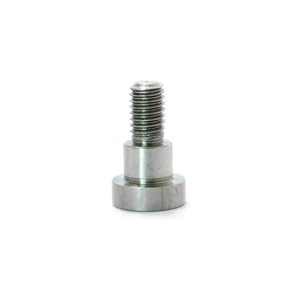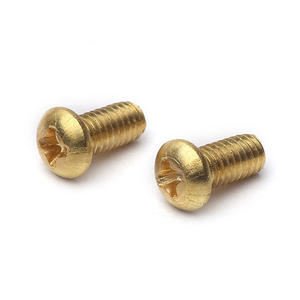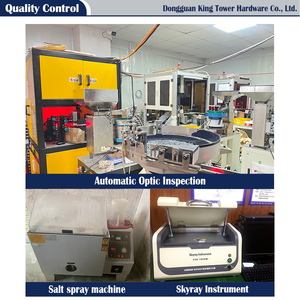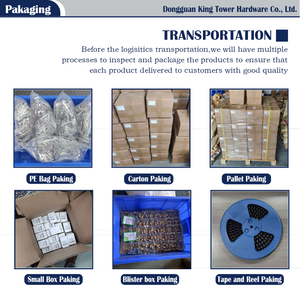
All categories
Featured selections
Trade Assurance
Buyer Central
Help Center
Get the app
Become a supplier

(3704 products available)






































Every type of spring-loaded screw is suitable for other applications due to specific design 'modifications' for the operating environment. They screw, moreover, can harbor a type of spring and different forms depending on the situation and optimal performance, thus promoting the following.
The compression type of spring is in such a manner constructed to be compressed along the axis of the screw. Such type of screw is used in applications where a compressive axial load is predominant and needs to be accommodated. The compressive coil gradually compresses as the load is applied until it reaches the maximum allowable deformation, after which the coil will not regain original form. They are widely used in spring-loaded screws.
As the name suggests, tension springs screws are made of extension type of spring. The extension spring tension screw is intended to pull or stretch the screw away from its original position. It is ideal for applications where tensile loads are present. The core allows for some elastic movement for a longer period. Thus, such screws are used where the constant pull is needed. Examples include conveyor car clamping mechanisms and securing parts for operation.
Torsion spring screws, unlike compression and extension spring screws, are situated to operate on the principle of twisting. These springs provide torque rather than axial forces of compression or extension. Torsion springs store energy in a twisted form primarily used in devices where rotational operation elements are critical, for example, in rotary handles or garage doors.
These screws consist of springs with helical grooves that can be compressed but cannot be fully extended. The spring structure makes it possible to absorb shock or impact loads. Usually found in automotive suspensions and similar applications, these springs fit into a descending groove, allowing a smaller overall size for the spring compared to compression or extension types.
Spring-loaded screws are actually critical components widely used in automotive, aerospace, and electronics engineering fields noted for their ability to absorb shock, accommodate thermal, and facilitate dynamic load adjustment. The following sections describe some of the prime applications of these versatile fasteners.
Spring-loaded screws in vehicles make fastening systems where tolerance and flexibility are desired. They are significant in assembling engine components, suspension systems, and electronic controls. Similarly, spring screws help absorb vibrations and shocks, making the vehicle cab more flexible and ensuring the mechanodynamic system works smoothly. They've become vital for launch restraints in keeping loose wiring or hardware in secure positions and fitting during vehicle operation, especially in high-MG applications.
The aerospace industry has extreme demands with weight considerations and reliability. Spring-loaded screws are used in systems such as rigid but lightweight, thermal and dynamic loads, and even in aircraft and spacecraft components. These screws are found in avionics systems, fuselage structures, and satellite systems. They also help maintain constant pressure on the connection, preventing loosening of the screws due to extreme altitude and velocity changes.
Spring-loaded screws are widely utilized, especially when assembling smartphones, laptops, and other gadgets. In these industries, compactness, precision, and flexibility are slight causes desired for the function of a fastener. Spring screws are used to hold tight components, such as batteries or circuit boards, but allow small necessary movements to prevent the parts from cracking. Also, they enable thermal management, preventing overheating on the device to protect electronic elements. In both electronic and aero space engineering, the material used in making the spring screw is critical; therefore, titanium/super alloys complicate but with a good strength-to-weight ratio.
The spring screws consist of a shaft, a helical spring, and a feature where the contact head of the screw contracts to accommodate the screw fastening. The screw shaft has different diameters depending on the design consideration, including the static or dynamic load capacity of the industrial application/norm, the material used, and the shape consistency with the encased structure. Common materials include stainless steel, titanium, and nickel alloy from which it's constructed due to strength, flexibility, and resistance to corrosion.
The helical spring part of the screw is categorized into three types: compression springs, extension springs, and torsion springs, depending on the operational requirements. The function is to store elastic energy and release it upon application to allow movement. The coil shape, pitch, and wire diameter influence the spring's properties, such as the load it can carry and the movement possible.
Some spring screws come with additional protective coatings, such as zinc plating, anti-corrosion, and abrasion resistance, which are desirable for outdoor and marine applications. Protective rubber seals are sometimes added to enhance protection from contaminants, such as dust and water, which might affect the performance in critical areas.
The performance and reliability of spring-loaded screws directly impact the system, especially where engineered dynamics are critical. Various quality and inspection standards have been put in place to ensure these fasteners meet the required operational demands. In the design and selection stage, one must adhere to certain standards, including ASTM (American Society for Testing and Materials), ISO (International Organization for Standardization), SAE (Society of Automotive Engineers), and ASME (American Society of Mechanical Engineers). Each has some specific tests related to the features of a spring screw.
ASTM defines guidelines for materials, mechanical properties, and testing methods for spring screws. For example, ASTM F 468 deals with corrosion-resistant screw fasteners that help orient the fixation in harsh environments, while the mechanical properties relating to elasticity and fatigue spring materials are enshrined in ASTM E 290.
ISO standards mainly deal with dimensional verification, tolerance, and material quality. ISO 3506 describes requirements for corrosion-resistant stainless screws; ISO 10987 describes requirements for fasteners in the strong fixation of mechanical joints. These standards ensure consistent quality regarding the fixatives in mechanical joints.
ANSI (American National Standards Institute) standards cover screw dimensions, threads, and tolerances. Such specifications make the screw conforming parts inter-changeable. Inspection often involves measuring the screw dimension with vernier gauges, thread templates, and other measuring professional equipment, including micro-CT, which gives a 3D view of the part without cutting it open, and mechanical strength testing equipment like a tensile/compression machine.
Besides that, Quality control testing typically involves a combined effort at the manufacturer using fatigue tests, environmental exposure tests, and, perhaps most crucially, elasticity measurements of the spring to ascertain that the product meets all functional demands of the end-user within a given set of parameters. Thus, this synergy is between various standardization bodies to maintain the fixation's structural integrity in critical applications.
Although required in specialized industrial applications, several factors come into play when choosing the correct spring-loaded screw so that it returns the desired performance. Chief among these are the size and material, among others. For example, the spring screw material needs to be tougher than the general applied load to make it non-deform during application.
Depending on the project, there are several materials: titanium, for an irritant environment, and steel alloy, which is used commonly as the material for making spring screws due to strength. There are different variations of spring screws, depending on the operational dynamics: compression springs for axial load applications demand, extension springs for applications that need a constant pull, torsion springs, and twisting applications.
The type of coating placed on the spring screw is vital, especially where the conditions are corrosive; options for coating are zinc plating, nickel, or rubber- polymer based, which is invaluable. In selecting a spring-loaded screw, factors such application type, operating load, environmental conditions, and requirements concerning elasticity must be adhered to ensure the chosen part meets the functional demand of the application, especially in critical assemblies.
A1: These screws are normally made from stainless steel, titanium alloy intending for hostile environments and weight considerations.
A2: In general, they are used in automotive, aerospace, and electronics because the spring screws can absorb shocks and allow adjustments.
A3: Adhering to standards set by ASTM, ISO, and SAE, will ensure the performance and quality of the product for specific uses.
A4: Application-type, operating load, environmental factors, coherence elasticity requirements, guidance in choosing the relevant one for the application, and journey criteria.
A5: Yes, spring-loaded screws are often coated with a zinc jacket, nickel, and occasionally additions of rubber to increase protection from corrosion and abrasion.